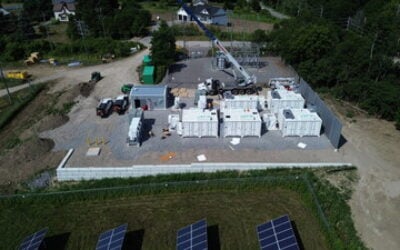
Currently attracting developers and investment alike, the opportunity to reduce energy costs for businesses in Ontario has led to an agreement for another 42MWh of energy storage from project developer NRStor and solutions provider IHI Inc.
Ontario’s commercial and industrial (C&I) energy storage space has been found to offer one of the best policy-driven economic opportunities for reducing peak demand and therefore electricity bills in the Global Adjustment Charge.
The policy is a means by which to pay for the Canadian province’s grid upgrades and maintenance as well as for the development and promotion of clean energy and energy efficiency. Energy-Storage.news has reported on numerous multi-megawatt projects from the region in recent months, including last week, when multinational utility Enel said its second megawatt-scale C&I project in Ontario would save the customer, food packaging company Amhil North America, around 20% on current energy costs at the facility where the installation is being made.
In an announcement made this morning, NRStor, a developer founded in Canada in 2012, said it has signed a memorandum of understanding (MOU) with IHI Energy Storage, with the latter set to supply energy storage solutions for eight contracted projects which will add up to 42MWh of energy storage. The projects will be completed during 2019, with no further details of timelines given at this stage.
Try Premium for just $1
- Full premium access for the first month at only $1
- Converts to an annual rate after 30 days unless cancelled
- Cancel anytime during the trial period
Premium Benefits
- Expert industry analysis and interviews
- Digital access to PV Tech Power journal
- Exclusive event discounts
Or get the full Premium subscription right away
Or continue reading this article for free
Each project will be a behind-the-meter, customer-sited lithium-ion battery system. IHI Energy Storage will deliver batteries, inverters, temperature-controlled enclosures and balance of plant components as well as putting the solutions under warranty and performing operations and maintenance (O&M) tasks. They will utilise IHI Energy Storage’s proprietary software, ESWare.
NRStor in early 2017 closed a deal with a union-backed pension fund, Labourers’ Pension Fund of Central and Eastern Canada (LiUNA), which committed CAN$200 million (US$151 million) of project financing towards NRStor projects. That deal was considered something of a vindication of the appeal of the Ontario energy storage market, as was the market entry of SUSI Partners, a Switzerland-headquartered investment fund aimed at encouraging institutional investors to get on board with energy storage, which reached its first closing at €66 million (US$70.4 million) in April last year. NRStor itself is also active in other areas, striking a deal with advanced adiabatic compressed air energy storage (A-CAES) firm Hydrostor for a potential roll-out of the latter’s utility-scale systems across Canada.
IHI Energy Storage meanwhile is a subsidiary of IHI, Inc, New York, in turn owned by Japan’s IHI Corporation. The energy storage division integrates systems and provides solutions for energy storage both in-front-of-the-meter (FTM) at grid-scale and behind-the-meter (BTM) on customer sites. In October 2017, Energy-Storage.news reported that the company was providing a renewables integrating 500kW/2.5MWh energy storage system in Japan’s Fukushima region.
In other Ontario clean energy news, a few days ago the province’s Ministry of Energy, Northern Development and Mines announced that contracts for some 758 renewable energy projects have been cancelled. This decision has been made in order to cut the cost of hydroelectric power for ratepayers, resulting in CA$790 million of savings, equivalent to 12% reduction in the hydro rates for “families, farmers and small businesses”, minister Greg Rickford said.
“For 15 years, Ontario families and businesses have been forced to pay inflated hydro prices, so the government could spend on unnecessary and expensive energy schemes. Those days are over,” Rickford said.
The list of cancelled projects can be seen here.





